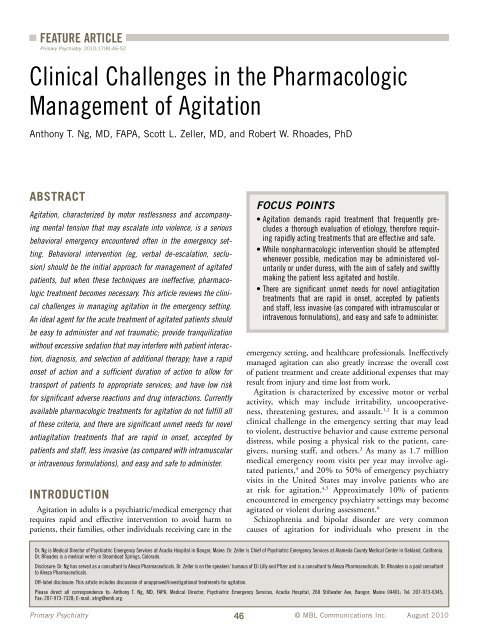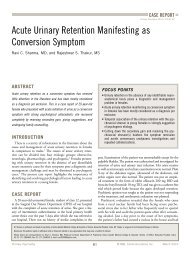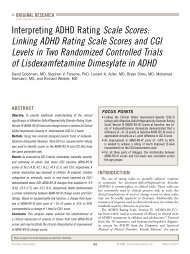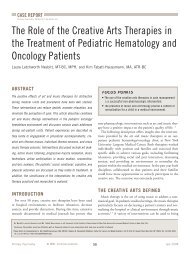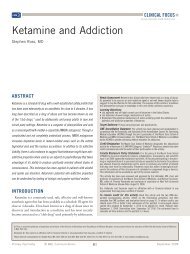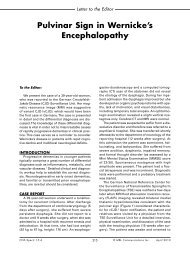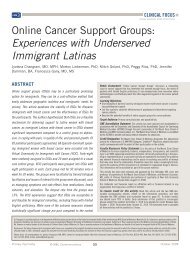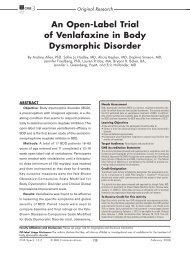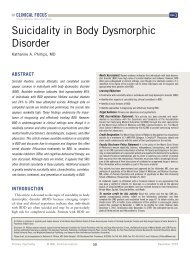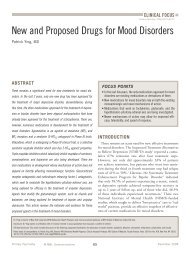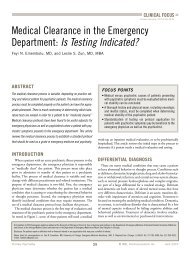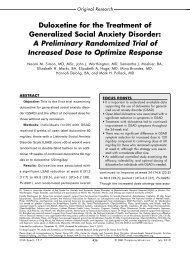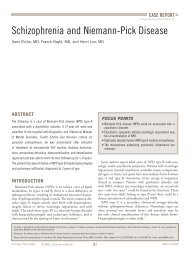Clinical Challenges in the Pharmacologic Management of Agitation
Clinical Challenges in the Pharmacologic Management of Agitation
Clinical Challenges in the Pharmacologic Management of Agitation
Create successful ePaper yourself
Turn your PDF publications into a flip-book with our unique Google optimized e-Paper software.
FEATURE ARTICLE<br />
Primary Psychiatry. 2010;17(8):46-52<br />
A.T. Ng, S.L. Zeller, R.W. Rhoades<br />
<strong>Cl<strong>in</strong>ical</strong> <strong>Challenges</strong> <strong>in</strong> <strong>the</strong> <strong>Pharmacologic</strong><br />
<strong>Management</strong> <strong>of</strong> <strong>Agitation</strong><br />
Anthony T. Ng, MD, FAPA, Scott L. Zeller, MD, and Robert W. Rhoades, PhD<br />
ABSTRACT<br />
<strong>Agitation</strong>, characterized by motor restlessness and accompany-<br />
<strong>in</strong>g mental tension that may escalate <strong>in</strong>to violence, is a serious<br />
behavioral emergency encountered <strong>of</strong>ten <strong>in</strong> <strong>the</strong> emergency set-<br />
t<strong>in</strong>g. Behavioral <strong>in</strong>tervention (eg, verbal de-escalation, seclu-<br />
sion) should be <strong>the</strong> <strong>in</strong>itial approach for management <strong>of</strong> agitated<br />
patients, but when <strong>the</strong>se techniques are <strong>in</strong>effective, pharmaco-<br />
logic treatment becomes necessary. This article reviews <strong>the</strong> cl<strong>in</strong>i-<br />
cal challenges <strong>in</strong> manag<strong>in</strong>g agitation <strong>in</strong> <strong>the</strong> emergency sett<strong>in</strong>g.<br />
An ideal agent for <strong>the</strong> acute treatment <strong>of</strong> agitated patients should<br />
be easy to adm<strong>in</strong>ister and not traumatic; provide tranquilization<br />
without excessive sedation that may <strong>in</strong>terfere with patient <strong>in</strong>terac-<br />
tion, diagnosis, and selection <strong>of</strong> additional <strong>the</strong>rapy; have a rapid<br />
onset <strong>of</strong> action and a sufficient duration <strong>of</strong> action to allow for<br />
transport <strong>of</strong> patients to appropriate services; and have low risk<br />
for significant adverse reactions and drug <strong>in</strong>teractions. Currently<br />
available pharmacologic treatments for agitation do not fulfill all<br />
<strong>of</strong> <strong>the</strong>se criteria, and <strong>the</strong>re are significant unmet needs for novel<br />
antiagitation treatments that are rapid <strong>in</strong> onset, accepted by<br />
patients and staff, less <strong>in</strong>vasive (as compared with <strong>in</strong>tramuscular<br />
or <strong>in</strong>travenous formulations), and easy and safe to adm<strong>in</strong>ister.<br />
INTRODUCTION<br />
<strong>Agitation</strong> <strong>in</strong> adults is a psychiatric/medical emergency that<br />
requires rapid and effective <strong>in</strong>tervention to avoid harm to<br />
patients, <strong>the</strong>ir families, o<strong>the</strong>r <strong>in</strong>dividuals receiv<strong>in</strong>g care <strong>in</strong> <strong>the</strong><br />
Primary Psychiatry<br />
46<br />
emergency sett<strong>in</strong>g, and healthcare pr<strong>of</strong>essionals. Ineffectively<br />
managed agitation can also greatly <strong>in</strong>crease <strong>the</strong> overall cost<br />
<strong>of</strong> patient treatment and create additional expenses that may<br />
result from <strong>in</strong>jury and time lost from work.<br />
<strong>Agitation</strong> is characterized by excessive motor or verbal<br />
activity, which may <strong>in</strong>clude irritability, uncooperativeness,<br />
threaten<strong>in</strong>g gestures, and assault. 1,2 It is a common<br />
cl<strong>in</strong>ical challenge <strong>in</strong> <strong>the</strong> emergency sett<strong>in</strong>g that may lead<br />
to violent, destructive behavior and cause extreme personal<br />
distress, while pos<strong>in</strong>g a physical risk to <strong>the</strong> patient, caregivers,<br />
nurs<strong>in</strong>g staff, and o<strong>the</strong>rs. 3 As many as 1.7 million<br />
medical emergency room visits per year may <strong>in</strong>volve agitated<br />
patients, 4 and 20% to 50% <strong>of</strong> emergency psychiatry<br />
visits <strong>in</strong> <strong>the</strong> United States may <strong>in</strong>volve patients who are<br />
at risk for agitation. 4,5 Approximately 10% <strong>of</strong> patients<br />
encountered <strong>in</strong> emergency psychiatry sett<strong>in</strong>gs may become<br />
agitated or violent dur<strong>in</strong>g assessment. 6<br />
Schizophrenia and bipolar disorder are very common<br />
causes <strong>of</strong> agitation for <strong>in</strong>dividuals who present <strong>in</strong> <strong>the</strong><br />
Dr. Ng is Medical Director <strong>of</strong> Psychiatric Emergency Services at Acadia Hospital <strong>in</strong> Bangor, Ma<strong>in</strong>e. Dr. Zeller is Chief <strong>of</strong> Psychiatric Emergency Services at Alameda County Medical Center <strong>in</strong> Oakland, California.<br />
Dr. Rhoades is a medical writer <strong>in</strong> Steamboat Spr<strong>in</strong>gs, Colorado.<br />
Disclosure: Dr. Ng has served as a consultant to Alexza Pharmaceuticals. Dr. Zeller is on <strong>the</strong> speakers’ bureaus <strong>of</strong> Eli Lilly and Pfizer and is a consultant to Alexza Pharmaceuticals. Dr. Rhoades is a paid consultant<br />
to Alexza Pharmaceuticals.<br />
Off-label disclosure: This article <strong>in</strong>cludes discussion <strong>of</strong> unapproved/<strong>in</strong>vestigational treatments for agitation.<br />
FOCUS POINTS<br />
• <strong>Agitation</strong> demands rapid treatment that frequently precludes<br />
a thorough evaluation <strong>of</strong> etiology, <strong>the</strong>refore requir<strong>in</strong>g<br />
rapidly act<strong>in</strong>g treatments that are effective and safe.<br />
• While nonpharmacologic <strong>in</strong>tervention should be attempted<br />
whenever possible, medication may be adm<strong>in</strong>istered voluntarily<br />
or under duress, with <strong>the</strong> aim <strong>of</strong> safely and swiftly<br />
mak<strong>in</strong>g <strong>the</strong> patient less agitated and hostile.<br />
• There are significant unmet needs for novel antiagitation<br />
treatments that are rapid <strong>in</strong> onset, accepted by patients<br />
and staff, less <strong>in</strong>vasive (as compared with <strong>in</strong>tramuscular or<br />
<strong>in</strong>travenous formulations), and easy and safe to adm<strong>in</strong>ister.<br />
Please direct all correspondence to: Anthony T. Ng, MD, FAPA, Medical Director, Psychiatric Emergency Services, Acadia Hospital, 268 Stillwater Ave, Bangor, Ma<strong>in</strong>e 04401; Tel: 207-973-6345;<br />
Fax: 207-973-7328; E-mail: atng@emh.org.<br />
© MBL Communications Inc. August 2010
emergency department. 5,7,8 Patients with psychoses result<br />
<strong>in</strong> ~900,000 emergency department visits annually. 5<br />
Schizophrenia is disproportionately common among homeless<br />
people, with an <strong>in</strong>cidence <strong>of</strong> 27%, which contributes to<br />
<strong>the</strong>ir high frequency <strong>of</strong> presentation with agitation <strong>in</strong> <strong>the</strong><br />
emergency department. 7 It is important to note that agitation<br />
among patients with schizophrenia or bipolar disorder<br />
may be precipitated or exacerbated by both patient-related<br />
factors (eg, male, younger age, history <strong>of</strong> substance abuse,<br />
poor adherence to antipsychotics, history <strong>of</strong> physically<br />
aggressive behavior, 9-12 and <strong>the</strong> characteristics <strong>of</strong> <strong>the</strong> environment<br />
<strong>in</strong> which <strong>the</strong>y are managed (eg, an overcrowded<br />
emergency department). 13 Unpremeditated violence <strong>in</strong><br />
patients with agitation is <strong>of</strong>ten preceded by a prodromal<br />
period <strong>of</strong> 30–60 m<strong>in</strong>utes, dur<strong>in</strong>g which <strong>the</strong>y may exhibit<br />
<strong>in</strong>creased pac<strong>in</strong>g or loud speech. 14 Recogniz<strong>in</strong>g <strong>the</strong>se prodromal<br />
symptoms provides an opportunity for early deescalation<br />
and/or <strong>of</strong>fer<strong>in</strong>g pharmacologic treatment.<br />
Several tools have been developed to assist <strong>in</strong> <strong>the</strong> identification<br />
<strong>of</strong> patients who are likely to become violent <strong>in</strong><br />
different treatment sett<strong>in</strong>gs. The Brøset Violence Checklist<br />
(BVC) measures confusion, irritability, boisterousness, physical<br />
threats, verbal threats, and attacks on objects with each<br />
scored for its presence (1) or absence (0). The sum <strong>of</strong> scores<br />
is <strong>the</strong>n totaled with a total score <strong>of</strong> 0, suggest<strong>in</strong>g that <strong>the</strong><br />
risk <strong>of</strong> violence is small; scores 1 and 2 suggest that <strong>the</strong> risk<br />
<strong>of</strong> violence is moderate, and preventive measures should<br />
be taken; and scores ≥3 <strong>in</strong>dicate that <strong>the</strong> risk <strong>of</strong> violence is<br />
very high and that action should be taken. 15 The Historical,<br />
<strong>Cl<strong>in</strong>ical</strong>, and Risk <strong>Management</strong> Violence Risk Assessment<br />
Scheme is a 20-item scale that ga<strong>the</strong>rs <strong>in</strong>formation about<br />
past history <strong>of</strong> violence, current cl<strong>in</strong>ical status, and environmental/support<br />
factors that may <strong>in</strong>crease risk for violence. 16<br />
It has been shown to be useful for <strong>the</strong> cl<strong>in</strong>ical psychiatric,<br />
forensic, and correctional sett<strong>in</strong>gs. 16 A third tool that<br />
may be useful for prediction <strong>of</strong> violence <strong>in</strong> <strong>the</strong> emergency<br />
department is <strong>the</strong> McNeil-B<strong>in</strong>der Checklist, which evaluates<br />
history <strong>of</strong> physical attacks or fear-<strong>in</strong>duc<strong>in</strong>g behavior<br />
with<strong>in</strong> 2 weeks, absence <strong>of</strong> suicidal behavior, schizophrenic<br />
or manic diagnosis, male gender, and currently married or<br />
liv<strong>in</strong>g toge<strong>the</strong>r status, to predict violent behavior. It has been<br />
shown to have a sensitivity <strong>of</strong> 57.2% and a specificity <strong>of</strong><br />
70.0% for prediction <strong>of</strong> violence <strong>in</strong> psychiatric <strong>in</strong>patients. 17<br />
None <strong>of</strong> <strong>the</strong>se prediction tools have been evaluated <strong>in</strong> <strong>the</strong><br />
emergency department and all but <strong>the</strong> BVC require at least<br />
some <strong>in</strong>formation about <strong>the</strong> patient’s history.<br />
The occurrence <strong>of</strong> agitation and violence significantly<br />
impacts <strong>the</strong> agitated <strong>in</strong>dividual, o<strong>the</strong>r patients around him<br />
or her, and healthcare personnel. 18 Results from one survey<br />
<strong>of</strong> psychiatric emergency services <strong>in</strong> <strong>the</strong> US <strong>in</strong>dicated<br />
that agitation resulted <strong>in</strong> an average <strong>of</strong> 8 patient-to-staff<br />
assaults per facility each year. 19 Most <strong>of</strong> <strong>the</strong>se episodes<br />
<strong>Cl<strong>in</strong>ical</strong> <strong>Challenges</strong> <strong>in</strong> <strong>the</strong> <strong>Pharmacologic</strong> <strong>Management</strong> <strong>of</strong> <strong>Agitation</strong><br />
caused <strong>in</strong>juries to personnel that were sufficiently severe to<br />
result <strong>in</strong> absences from work. 19 Results from one study 20 <strong>of</strong><br />
violence <strong>in</strong> <strong>the</strong> emergency department <strong>in</strong>dicated that 80%<br />
<strong>of</strong> respondents reported that at least one staff member had<br />
been <strong>in</strong>jured by a violent patient <strong>in</strong> <strong>the</strong> preced<strong>in</strong>g 5 years,<br />
and 43% reported physical attacks on staff at least once per<br />
month. Results from ano<strong>the</strong>r survey 21 <strong>of</strong> 106 emergency<br />
department personnel <strong>in</strong>dicated that 57% were physically<br />
assaulted, 48% reported impaired job performance for <strong>the</strong><br />
rest <strong>of</strong> <strong>the</strong> shift or <strong>the</strong> rest <strong>of</strong> <strong>the</strong> week after an <strong>in</strong>cident<br />
<strong>of</strong> violence, 73% were afraid <strong>of</strong> patients as a result <strong>of</strong> violence,<br />
and 25% took days <strong>of</strong>f because <strong>of</strong> violence.<br />
The symptoms <strong>of</strong> agitation may be very similar across<br />
a wide range <strong>of</strong> diagnoses, <strong>in</strong>clud<strong>in</strong>g medical conditions,<br />
toxicity, and psychiatric illness (Table 1). 22-27 The terms<br />
used to def<strong>in</strong>e agitation typically <strong>in</strong>clude <strong>in</strong>creased psychomotor<br />
activity; aggression; dis<strong>in</strong>hibition/impulsivity;<br />
and irritable, anxious, or labile mood. 28 Numerous different<br />
def<strong>in</strong>itions for agitation have been put forward <strong>in</strong> <strong>the</strong><br />
medical literature, and <strong>the</strong>y vary based on <strong>the</strong> condition<br />
(eg, dementia, traumatic bra<strong>in</strong> <strong>in</strong>jury, schizophrenia, bipolar<br />
disorder) believed to underlie patients’ symptoms. 28 It<br />
has been suggested that <strong>the</strong> lack <strong>of</strong> a uniform and precise<br />
def<strong>in</strong>ition <strong>of</strong> agitation may contribute to misrecognition<br />
(both over- and underrecognition) <strong>of</strong> this condition and<br />
misdeterm<strong>in</strong>ation <strong>of</strong> its causes <strong>in</strong> <strong>the</strong> acute care sett<strong>in</strong>g. 28<br />
The etiology <strong>of</strong> agitation is not completely understood, but<br />
TABLE 1<br />
CONDITIONS ASSOCIATED WITH AGITATION 22-27<br />
Medical causes:<br />
• Thyrotoxicosis<br />
• Encephalitis<br />
• Men<strong>in</strong>gitis<br />
• Sepsis<br />
• Bra<strong>in</strong> trauma<br />
• Dementia<br />
• Delirium<br />
• Seizure disorders<br />
Primary Psychiatry 47<br />
© MBL Communications Inc. August 2010<br />
Toxicity:<br />
• Intoxication (alcohol, coca<strong>in</strong>e, methamphetam<strong>in</strong>e)<br />
• Alcohol withdrawal<br />
Psychiatric disease:<br />
• Schizophrenia<br />
• Schizoaffective disorder<br />
• Schizophreniform disorder<br />
• Brief psychotic disorder<br />
• Bipolar disorder<br />
• Borderl<strong>in</strong>e personality disorder<br />
• Obsessive-compulsive disorder<br />
• Panic disorder<br />
• Posttraumatic stress disorder<br />
Ng AT, Zeller SL, Rhoades RW. Primary Psychiatry. Vol 17, No 8. 2010.
A.T. Ng, S.L. Zeller, R.W. Rhoades<br />
it is believed that abnormalities <strong>in</strong> <strong>the</strong> biogenic am<strong>in</strong>es—seroton<strong>in</strong>,<br />
dopam<strong>in</strong>e, and norep<strong>in</strong>ephr<strong>in</strong>e—as well as <strong>the</strong> <strong>in</strong>hibitory<br />
neurotransmitter γ-am<strong>in</strong>obutyric acid (GABA) are all<br />
<strong>in</strong>volved. 29-31 It has been suggested that agitation associated<br />
with psychosis, mania, and substance abuse may be correlated<br />
with elevated dopam<strong>in</strong>ergic neurotransmission, and that<br />
decreased GABAergic transmission is characteristic <strong>of</strong> agitation<br />
associated with dementia, depression, and anxiety. 32<br />
<strong>Agitation</strong> demands rapid treatment that frequently precludes<br />
a thorough evaluation <strong>of</strong> etiology. Cl<strong>in</strong>icians <strong>the</strong>refore<br />
require rapidly act<strong>in</strong>g treatments that are effective and<br />
safe, regardless <strong>of</strong> <strong>the</strong> genesis <strong>of</strong> agitation. It is important<br />
to note that treatment requirements and unmet needs for<br />
<strong>the</strong> management <strong>of</strong> patients with agitation vary from one<br />
sett<strong>in</strong>g to ano<strong>the</strong>r and that those <strong>in</strong> <strong>the</strong> emergency department<br />
are very different from those for a patient present<strong>in</strong>g<br />
to a psychiatric cl<strong>in</strong>ic. 33-36 The etiology <strong>of</strong> agitation for <strong>the</strong><br />
patient <strong>in</strong> <strong>the</strong> emergency department may be unknown,<br />
while some patient history is likely to be available to personnel<br />
<strong>in</strong> <strong>the</strong> psychiatric cl<strong>in</strong>ic. Treatment selection may<br />
be more difficult <strong>in</strong> <strong>the</strong> emergency department versus <strong>the</strong><br />
psychiatric cl<strong>in</strong>ic because healthcare pr<strong>of</strong>essionals <strong>in</strong> <strong>the</strong><br />
psychiatric cl<strong>in</strong>ic may have more <strong>in</strong>formation about efficacy<br />
<strong>of</strong> prior treatments <strong>in</strong> a given patient.<br />
ACUTE MANAGEMENT OF THE<br />
AGITATED PATIENT<br />
Diagnosis and establishment <strong>of</strong> <strong>the</strong> acute treatment<br />
plan for <strong>the</strong> agitated patient is difficult because <strong>of</strong> <strong>the</strong><br />
immediate need for <strong>in</strong>tervention, which may <strong>in</strong>crease<br />
diagnostic difficulty.<br />
Establishment <strong>of</strong> a provisional diagnosis is a crucial step <strong>in</strong><br />
<strong>the</strong> management <strong>of</strong> <strong>the</strong> agitated patient, and medical causes<br />
<strong>of</strong> agitation and substance abuse should be ruled out, if possible,<br />
before assum<strong>in</strong>g a psychiatric etiology. Patient characteristics<br />
that <strong>in</strong>crease <strong>the</strong> probability <strong>of</strong> a non-psychiatric<br />
cause <strong>of</strong> agitation <strong>in</strong>clude lack <strong>of</strong> prior psychiatric history,<br />
older age, and new or pre-exist<strong>in</strong>g medical compla<strong>in</strong>ts. 37,38 It<br />
has been suggested that a brief medical work-up be carried<br />
out <strong>in</strong> patients without a psychiatric history, with features<br />
not consistent with a psychiatric diagnosis (eg, lethargy,<br />
confusion), with abnormal vital signs, with sudden onset <strong>of</strong><br />
agitation, and who are known to have recently started any<br />
new medications (eg, antichol<strong>in</strong>ergics, steroids). 39<br />
Ideally, <strong>in</strong>itial <strong>in</strong>tervention <strong>in</strong> <strong>the</strong> agitated patient should<br />
be as nonrestrictive as possible. Techniques such as verbal<br />
de-escalation (“talk<strong>in</strong>g <strong>the</strong> patient down”) or destimulation<br />
(plac<strong>in</strong>g <strong>the</strong> patient <strong>in</strong> a quiet room ) are effective <strong>in</strong> some<br />
agitated <strong>in</strong>dividuals and should be attempted prior to more<br />
forceful <strong>in</strong>terventions. 14,40<br />
While nonpharmacologic <strong>in</strong>tervention should be<br />
attempted whenever possible as a first step <strong>in</strong> <strong>the</strong> acute<br />
management <strong>of</strong> agitated patients, it is <strong>of</strong>ten <strong>in</strong>effective<br />
<strong>in</strong> some <strong>in</strong>dividuals who present <strong>in</strong> <strong>the</strong> emergency sett<strong>in</strong>g.<br />
18 Rapid and safe tranquilization <strong>of</strong> aggressive/violent<br />
patients is <strong>of</strong>ten necessary; medication may be given voluntarily<br />
or under duress, with <strong>the</strong> aim <strong>of</strong> safely and swiftly<br />
mak<strong>in</strong>g <strong>the</strong> patient less agitated and hostile. It should be<br />
noted that <strong>of</strong>fer<strong>in</strong>g <strong>the</strong> agitated patient medication can<br />
go hand-<strong>in</strong>-hand with non-restrictive <strong>in</strong>terventions such<br />
as verbal de-escalation and provid<strong>in</strong>g <strong>the</strong> patient with an<br />
opportunity for time <strong>in</strong> a quiet environment. 41 Involuntary<br />
adm<strong>in</strong>istration <strong>of</strong> medication should be considered coercive<br />
<strong>in</strong> <strong>the</strong> same sense as forced seclusion or restra<strong>in</strong>t.<br />
The goal <strong>of</strong> acute pharmacologic treatment for agitation<br />
is to calm <strong>the</strong> patient while avoid<strong>in</strong>g excessive sedation that<br />
can <strong>in</strong>terfere with <strong>the</strong> ability to cont<strong>in</strong>ue <strong>the</strong> psychiatric<br />
evaluation and <strong>in</strong>tervention. 42,43 Excessive sedation that<br />
results <strong>in</strong> a requirement for cont<strong>in</strong>uous observation and/or<br />
assistance with toilet<strong>in</strong>g also <strong>in</strong>creases <strong>the</strong> burden on emergency<br />
department staff. 36 Prompt adm<strong>in</strong>istration <strong>of</strong> effective<br />
medications to <strong>the</strong> agitated patient has <strong>the</strong> potential<br />
to reduce <strong>the</strong> probability <strong>of</strong> harm to self or o<strong>the</strong>rs, permit<br />
accomplishment <strong>of</strong> needed diagnostic tests, attenuate psychosis,<br />
and reduce <strong>the</strong> requirement for restra<strong>in</strong>t. 36<br />
The choice <strong>of</strong> medication for a patient with agitation<br />
should be guided by <strong>the</strong> etiology underly<strong>in</strong>g <strong>the</strong> episode if<br />
it is known. For example, agitation result<strong>in</strong>g from organic<br />
causes (eg, hypoglycemia, hypoxia, thyroid storm) should<br />
not be treated with an antipsychotic, while adm<strong>in</strong>istration<br />
<strong>of</strong> an antipsychotic and/or benzodiazep<strong>in</strong>e is appropriate<br />
for agitation that has a psychiatric etiology. 39 The rema<strong>in</strong>der<br />
<strong>of</strong> this article focuses on treatment <strong>of</strong> agitated patients<br />
us<strong>in</strong>g antipsychotics and benzodiazep<strong>in</strong>es.<br />
Current drugs used for <strong>the</strong> acute treatment <strong>of</strong> agitation may<br />
be adm<strong>in</strong>istered orally, <strong>in</strong>travenously (IV), or by <strong>in</strong>jections<br />
<strong>in</strong>to <strong>the</strong> muscle (<strong>in</strong>tramuscular [IM]). 44 Each <strong>of</strong> <strong>the</strong>se routes <strong>of</strong><br />
delivery may have important limitations. Adm<strong>in</strong>istration <strong>of</strong> an<br />
oral agent may not be possible <strong>in</strong> a very agitated patient and this<br />
route <strong>of</strong> adm<strong>in</strong>istration <strong>of</strong>ten results <strong>in</strong> a slow onset <strong>of</strong> action. 44<br />
Intravenous adm<strong>in</strong>istration <strong>of</strong> medications may result <strong>in</strong> a very<br />
rapid onset <strong>of</strong> action, but establish<strong>in</strong>g an IV l<strong>in</strong>e may be very<br />
difficult and potentially dangerous <strong>in</strong> <strong>the</strong> agitated patient. In<br />
addition, IV adm<strong>in</strong>istration <strong>of</strong> some medications used to treat<br />
agitation may result <strong>in</strong> cardiac and/or respiratory complications.<br />
44 Results from one study 45 have shown fur<strong>the</strong>r that IM<br />
adm<strong>in</strong>istration <strong>of</strong> haloperidol did not result <strong>in</strong> more rapid<br />
resolution <strong>of</strong> agitation than delivery <strong>of</strong> an oral concentrate.<br />
Similarly, comparison <strong>of</strong> <strong>the</strong> comb<strong>in</strong>ation <strong>of</strong> oral risperidone<br />
and oral lorazepam versus IM haloperidol plus IM lorazepam <strong>in</strong><br />
patients with agitation <strong>in</strong>dicated no significant between-treatment<br />
differences <strong>in</strong> onset <strong>of</strong> action. 46 Never<strong>the</strong>less, IM drug<br />
Primary Psychiatry 48<br />
© MBL Communications Inc. August 2010
adm<strong>in</strong>istration generally achieves <strong>the</strong>rapeutic concentrations<br />
more rapidly than oral delivery. 47 A recent systematic review 48<br />
<strong>of</strong> cl<strong>in</strong>ical trials focused on <strong>the</strong> acute treatment <strong>of</strong> agitation<br />
<strong>in</strong>dicated generally more rapid onset <strong>of</strong> action for IM versus<br />
oral adm<strong>in</strong>istration <strong>of</strong> <strong>the</strong> same agents.<br />
Intramuscular <strong>in</strong>jections are easier to adm<strong>in</strong>ister than IV<br />
<strong>in</strong>fusions, and some patients will agree to this route <strong>of</strong> delivery<br />
for medications to more rapidly control <strong>the</strong>ir agitation.<br />
However, <strong>the</strong> onset <strong>of</strong> action with IM <strong>in</strong>jection <strong>of</strong> a given<br />
medication may be slower and <strong>the</strong> pharmacologic effects<br />
more variable than those observed after IV adm<strong>in</strong>istration<br />
<strong>of</strong> <strong>the</strong> same drug. 49,50 For example, <strong>the</strong> onset <strong>of</strong> action with<br />
midazolam for calm<strong>in</strong>g agitated patients is 1–5 m<strong>in</strong>utes for<br />
IV delivery versus 18 m<strong>in</strong>utes for IM adm<strong>in</strong>istration. 51,52<br />
Additionally, <strong>the</strong> pa<strong>in</strong> associated with IM <strong>in</strong>jection may be<br />
poorly tolerated by some patients. 44 Any <strong>in</strong>tervention that is<br />
aversive to <strong>the</strong> patient, particularly if it is adm<strong>in</strong>istered <strong>in</strong>voluntarily,<br />
may be viewed as punishment and has <strong>the</strong> potential<br />
to impair <strong>the</strong> physician-patient relationship and effective longer-term<br />
management after resolution <strong>of</strong> <strong>the</strong> episode <strong>of</strong> agitation.<br />
42 Fur<strong>the</strong>r, approach<strong>in</strong>g <strong>the</strong> patient with a needle may<br />
<strong>in</strong>crease stress for both patients and <strong>the</strong>ir families and escalate<br />
agitation. 53 Both IV and IM adm<strong>in</strong>istration <strong>of</strong> medications to<br />
<strong>the</strong> agitated patient are also associated with <strong>the</strong> risk for needlestick<br />
<strong>in</strong>juries to emergency department staff. 54 Despite <strong>the</strong>se<br />
limitations, <strong>the</strong> relatively rapid onset <strong>of</strong> action for IM and IV<br />
adm<strong>in</strong>istration <strong>of</strong> antipsychotics and/or benzodiazep<strong>in</strong>es is an<br />
important advantage when <strong>the</strong> behavior <strong>of</strong> an agitated patient<br />
poses an imm<strong>in</strong>ent risk to himself and o<strong>the</strong>rs, and parenteral<br />
drug adm<strong>in</strong>istration is <strong>the</strong> only feasible treatment alternative.<br />
The characteristics <strong>of</strong> an ideal medication for <strong>the</strong> acute<br />
management <strong>of</strong> agitated patients have been set forth by<br />
several <strong>in</strong>vestigators (Table 2). 55,56 They <strong>in</strong>clude easy preparation<br />
by staff and nontraumatic adm<strong>in</strong>istration (no needles)<br />
with no associated pa<strong>in</strong> or requirement for restra<strong>in</strong>t;<br />
rapid onset <strong>of</strong> action with little <strong>in</strong>terpatient variability <strong>in</strong><br />
pharmacok<strong>in</strong>etics and pharmacodynamics; sufficient duration<br />
<strong>of</strong> effect for transport <strong>of</strong> patients to appropriate services;<br />
tranquilization without excessive sedation that may<br />
<strong>in</strong>terfere with patient <strong>in</strong>teraction, diagnosis, and selection<br />
<strong>of</strong> additional <strong>the</strong>rapy; and low risk for significant adverse<br />
reactions and drug <strong>in</strong>teractions. 55,56<br />
GUIDELINES FOR ACUTE MANAGEMENT OF<br />
AGITATION IN THE EMERGENCY SETTING<br />
Several guidel<strong>in</strong>es for <strong>the</strong> acute management <strong>of</strong> agitated<br />
patients have been published; those from <strong>the</strong> Jo<strong>in</strong>t Commission<br />
on Accreditation <strong>of</strong> Healthcare Organizations as well as <strong>the</strong><br />
Centers for Medicare and Medicaid Services <strong>in</strong>dicate that<br />
nonphysical forms <strong>of</strong> behavior management (eg, verbal <strong>in</strong>ter-<br />
<strong>Cl<strong>in</strong>ical</strong> <strong>Challenges</strong> <strong>in</strong> <strong>the</strong> <strong>Pharmacologic</strong> <strong>Management</strong> <strong>of</strong> <strong>Agitation</strong><br />
vention or show <strong>of</strong> force) are <strong>the</strong> appropriate first-l<strong>in</strong>e strategy.<br />
If medication is required, <strong>the</strong> use <strong>of</strong> oral drugs ra<strong>the</strong>r than IM<br />
preparations is recommended. 57 The Expert Consensus Panel<br />
for Behavioral Emergencies consensus regard<strong>in</strong>g <strong>the</strong> acute<br />
management <strong>of</strong> agitated patients <strong>in</strong> <strong>the</strong> emergency department<br />
sett<strong>in</strong>g differs somewhat from <strong>the</strong>se guidel<strong>in</strong>es. This consensus,<br />
based on responses to a survey completed by 48 experts<br />
<strong>in</strong> <strong>the</strong> acute management <strong>of</strong> agitated patients, <strong>in</strong>dicated that<br />
first-l<strong>in</strong>e oral options for <strong>the</strong> acute treatment <strong>of</strong> agitation associated<br />
with schizophrenia are olanzap<strong>in</strong>e alone, risperidone<br />
alone or comb<strong>in</strong>ed with a benzodiazep<strong>in</strong>e, and haloperidol<br />
plus a benzodiazep<strong>in</strong>e. Parenteral agents supported by experts<br />
<strong>in</strong>cluded IM olanzap<strong>in</strong>e and IM ziprasidone. The experts<br />
recommended <strong>in</strong>itial use <strong>of</strong> benzodiazep<strong>in</strong>es when no <strong>in</strong>formation<br />
was available about <strong>the</strong> patient’s condition, when <strong>the</strong>re<br />
was no specific treatment available for <strong>the</strong> patient’s condition,<br />
or when <strong>the</strong> patient was <strong>in</strong>toxicated. Haloperidol was viewed<br />
as be<strong>in</strong>g as effective as any currently available antipsychotic,<br />
and it was recommended that it should be adm<strong>in</strong>istered<br />
alone or with a benzodiazep<strong>in</strong>e unless <strong>the</strong> patient is medically<br />
compromised. 42 While <strong>the</strong>se expert recommendations<br />
provide guidance for optimal use <strong>of</strong> exist<strong>in</strong>g medications for<br />
<strong>the</strong> acute treatment <strong>of</strong> agitated patient, none <strong>of</strong> <strong>the</strong> currently<br />
recommended approaches meets all <strong>of</strong> <strong>the</strong> criteria for an ideal<br />
treatment set forth above (Table 2). 33-35,55,56<br />
LIMITATIONS OF CURRENT<br />
PHARMACOLOGIC TREATMENT OPTIONS<br />
Oral Drug Adm<strong>in</strong>istration<br />
Oral agents, particularly atypical or second-generation<br />
antipsychotics, have been used extensively for <strong>the</strong> acute treat-<br />
TABLE 2<br />
CHARACTERISTICS OF AN IDEAL MEDICATION FOR ACUTE<br />
MANAGEMENT OF THE AGITATED PATIENT 55,56<br />
• Easy preparation by staff and nontraumatic adm<strong>in</strong>istration (no needles)<br />
with no associated pa<strong>in</strong> or requirement for restra<strong>in</strong>t; possibility for self<br />
adm<strong>in</strong>istration.<br />
• Rapid onset <strong>of</strong> action with little <strong>in</strong>terpatient variability <strong>in</strong> pharmacok<strong>in</strong>etics<br />
and pharmacodynamics.<br />
• Offset sufficiently slow for transport <strong>of</strong> patient to appropriate services.<br />
• Provides tranquilization without excessive sedation that may <strong>in</strong>terfere with<br />
patient <strong>in</strong>teraction, diagnosis, and selection <strong>of</strong> additional <strong>the</strong>rapy.<br />
• Low risk for significant adverse reactions (acute movement disorders,<br />
especially dystonia, hypotension, cardiovascular events, dysphoria, neurologic<br />
events [eg, seizures]) and drug <strong>in</strong>teractions.<br />
Ng AT, Zeller SL, Rhoades RW. Primary Psychiatry. Vol 17, No 8. 2010.<br />
Primary Psychiatry 49<br />
© MBL Communications Inc. August 2010
A.T. Ng, S.L. Zeller, R.W. Rhoades<br />
ment <strong>of</strong> agitation, 36 but <strong>the</strong>y may be limited by slow onset<br />
<strong>of</strong> action. 58 Results from controlled cl<strong>in</strong>ical trials <strong>in</strong>dicate<br />
that <strong>the</strong> shortest onset <strong>of</strong> action for oral olanzap<strong>in</strong>e or haloperidol<br />
<strong>in</strong> patients experienc<strong>in</strong>g an episode <strong>of</strong> agitation is ~1<br />
hour. 59 The comb<strong>in</strong>ations <strong>of</strong> oral risperidone and lorazepam<br />
or haloperidol and lorazepam have been reported to have<br />
onsets <strong>of</strong> action <strong>of</strong> 30 m<strong>in</strong>utes <strong>in</strong> patients with agitation. 60<br />
Ano<strong>the</strong>r potential limitation <strong>of</strong> oral medications is patients<br />
“cheek<strong>in</strong>g” (tak<strong>in</strong>g, but not swallow<strong>in</strong>g) oral tablets. 55<br />
While not specifically approved for <strong>the</strong> treatment <strong>of</strong><br />
agitation, orally dis<strong>in</strong>tegrat<strong>in</strong>g formulations <strong>of</strong> several antipsychotics<br />
(eg, risperidone, olanzap<strong>in</strong>e, aripiprazole) have<br />
been developed. 59,61,62 This formulation may facilitate antipsychotic<br />
delivery to agitated patients, particular those who<br />
might not comply with treatment, but <strong>the</strong>ir pharmacok<strong>in</strong>etic<br />
pr<strong>of</strong>iles, <strong>in</strong>clud<strong>in</strong>g time to maximum plasma concentration,<br />
are equivalent to those for conventional tablets. 61,63,64<br />
Intramuscular Injection<br />
Intramuscular adm<strong>in</strong>istration <strong>of</strong> conventional or atypical<br />
antipsychotics provides more rapid onset <strong>of</strong> action than<br />
oral delivery, but may be associated with higher risk for<br />
adverse events and patient objections. Intramuscular ziprasidone<br />
has been shown to have an onset <strong>of</strong> action <strong>of</strong> ~30<br />
m<strong>in</strong>utes <strong>in</strong> agitated patients <strong>in</strong> one study. 65 Intramuscular<br />
olanzap<strong>in</strong>e is also rapidly absorbed and produces significant<br />
reductions <strong>in</strong> agitation with<strong>in</strong> 30 m<strong>in</strong>utes, but has<br />
been associated with significant reductions <strong>in</strong> systolic and<br />
diastolic blood pressure and pulse rate. 66,67<br />
Objection to IM <strong>in</strong>jection may create a barrier to this<br />
approach to acute treatment <strong>of</strong> agitation <strong>in</strong> many patients.<br />
Results from one survey <strong>in</strong>dicated that patients most preferred<br />
pills or capsules, followed by liquid medication,<br />
and <strong>the</strong>n “an <strong>in</strong>jection I agree to.” 56 Physicians are also<br />
concerned that <strong>in</strong>jected medication will compromise <strong>the</strong><br />
physician-patient relationship. 55<br />
Excessive Sedation<br />
While tranquiliz<strong>in</strong>g or calm<strong>in</strong>g <strong>the</strong> agitated patient is<br />
<strong>the</strong> central aim <strong>of</strong> pharmaco<strong>the</strong>rapy, avoid<strong>in</strong>g excessive<br />
sedation that may <strong>in</strong>terfere with fur<strong>the</strong>r evaluation and<br />
treatment is now also recognized as an important aspect<br />
<strong>of</strong> <strong>in</strong>tervention. Heavy sedation <strong>of</strong> patients may help to<br />
ensure <strong>the</strong> safety <strong>of</strong> both patients and staff, but it also<br />
makes it difficult or impossible to elicit useful <strong>in</strong>formation<br />
from <strong>the</strong>m. 3 Review <strong>of</strong> randomized cl<strong>in</strong>ical trial data <strong>in</strong>dicated<br />
that oral ziprasidone and quetiap<strong>in</strong>e (not approved<br />
for treatment <strong>of</strong> agitation) and IM olanzap<strong>in</strong>e have higher<br />
dose-related sedative potential while oral risperidone (not<br />
approved for treatment <strong>of</strong> agitation) and IM aripiprazole<br />
have lower sedative potential. 68 However, o<strong>the</strong>r studies<br />
have suggested that IM olanzap<strong>in</strong>e may have low risk for<br />
sedation <strong>in</strong> <strong>the</strong> acute treatment sett<strong>in</strong>g. 69,70<br />
While <strong>the</strong> risk with IM adm<strong>in</strong>istration <strong>of</strong> antipsychotics<br />
for excessive sedation that may <strong>in</strong>terfere with fur<strong>the</strong>r<br />
patient evaluation and <strong>in</strong>tervention appears to be lower<br />
than that after oral delivery, 36,55 results from several studies<br />
have <strong>in</strong>dicated that IM formulations <strong>of</strong> some atypical<br />
antipsychotics do have at least some liability for excessive<br />
sedation. In contrast to <strong>the</strong> conclusions from Cañas, 68<br />
results from a study 28 compar<strong>in</strong>g IM aripiprazole and<br />
IM lorazepam <strong>in</strong>dicated excessive sedation (<strong>Agitation</strong>-<br />
Calmness Evaluation Scale score <strong>of</strong> 8 or 9) dur<strong>in</strong>g <strong>the</strong><br />
<strong>in</strong>itial 2 hours after first <strong>in</strong>jection <strong>in</strong> 17.3% and 19.1% <strong>of</strong><br />
aripiprazole- and lorazepam-treated patients, respectively.<br />
Parenterally adm<strong>in</strong>istered benzodiazep<strong>in</strong>es have also been<br />
associated with excessive sedation. 71 The comb<strong>in</strong>ation <strong>of</strong><br />
<strong>the</strong>se drugs with a conventional or atypical antipsychotic<br />
may fur<strong>the</strong>r <strong>in</strong>crease <strong>the</strong> risk for excessive sedation versus<br />
treatment with s<strong>in</strong>gle agents.<br />
O<strong>the</strong>r Adverse Events Associated with Current<br />
Acute Treatments for <strong>Agitation</strong><br />
All agents currently used for <strong>the</strong> acute treatment <strong>of</strong> agitation<br />
have <strong>the</strong> potential for cl<strong>in</strong>ically important adverse events.<br />
Conventional antipsychotics (eg, haloperidol) may produce<br />
dysphoria, dystonia, and akathisia (<strong>in</strong> up to 33% <strong>of</strong> patients),<br />
as well as postural hypotension lead<strong>in</strong>g to syncope, and possible<br />
cardiac events. In addition to be<strong>in</strong>g aversive to patients,<br />
<strong>the</strong> symptoms <strong>of</strong> akathisia may be confused with <strong>the</strong> underly<strong>in</strong>g<br />
agitation. 36 This has <strong>the</strong> potential to lead to <strong>in</strong>appropriate<br />
<strong>in</strong>creases <strong>in</strong> drug dos<strong>in</strong>g. Conventional neuroleptics (eg, haloperidol)<br />
<strong>of</strong>ten require <strong>the</strong> use <strong>of</strong> concomitant antichol<strong>in</strong>ergics<br />
to prevent or treat extrapyramidal symptoms, and adm<strong>in</strong>istration<br />
<strong>of</strong> <strong>the</strong>se drugs can lead to cognitive disturbances.<br />
Treatment with conventional neuroleptics may also lead to<br />
neuroleptic malignant syndrome, particularly when adm<strong>in</strong>istered<br />
<strong>in</strong> high doses to agitated patients. 72 Acute dystonic<br />
reactions, which may be life threaten<strong>in</strong>g, have been reported<br />
to occur <strong>in</strong> 9% <strong>of</strong> agitated patients treated with haloperidol. 73<br />
Due <strong>in</strong> large part to <strong>the</strong>se limitations, <strong>the</strong> use <strong>of</strong> conventional<br />
antipsychotics is no longer considered “best practice” for any<br />
<strong>of</strong> <strong>the</strong> major conditions contribut<strong>in</strong>g to agitation. 55,74<br />
Adm<strong>in</strong>istration <strong>of</strong> atypical antipsychotics may also result<br />
<strong>in</strong> significant adverse events when used <strong>in</strong> <strong>the</strong> acute care<br />
sett<strong>in</strong>g. Treatment with olanzap<strong>in</strong>e may lead to bradycardia,<br />
orthostatic hypotension, and <strong>in</strong>creased somnolence<br />
when adm<strong>in</strong>istered with lorazepam. 55 Risperidone may be<br />
associated with <strong>the</strong> development <strong>of</strong> extrapyramidal symptoms.<br />
75 Ziprasidone may produce nausea, headache, dizz<strong>in</strong>ess,<br />
and possible risk for QTc prolongation. 55 Quetiap<strong>in</strong>e<br />
may result <strong>in</strong> orthostatic hypotension. 76 Aripiprazole may<br />
produce nausea and vomit<strong>in</strong>g. 77<br />
Primary Psychiatry 50<br />
© MBL Communications Inc. August 2010
Medications used for <strong>the</strong> acute treatment <strong>of</strong> agitation<br />
also have <strong>the</strong> potential for cl<strong>in</strong>ically significant drug-drug<br />
<strong>in</strong>teractions; this is especially important <strong>in</strong> patients with<br />
comorbid medical conditions. Lorazepam has a substantial<br />
potential for <strong>in</strong>teractions with prescription drugs, drugs <strong>of</strong><br />
abuse, and alcohol. 78 Haloperidol, ziprasidone, aripiprazole,<br />
and quetiap<strong>in</strong>e are all metabolized, at least partially, by cytochrome<br />
P450 (CYP) 3A4 and may <strong>in</strong>teract with agents that<br />
<strong>in</strong>duce or <strong>in</strong>hibit this enzyme, <strong>in</strong>clud<strong>in</strong>g carbamazep<strong>in</strong>e,<br />
valproate, phenyto<strong>in</strong>, phenobarbital, rifampic<strong>in</strong>, qu<strong>in</strong>id<strong>in</strong>e,<br />
glucocorticoids, and macrolide antibiotics. 79-81 Olanzap<strong>in</strong>e is<br />
metabolized by CYP 2D6 and 1A2, and it may <strong>in</strong>teract with<br />
fluvoxam<strong>in</strong>e, fluoxet<strong>in</strong>e, sertral<strong>in</strong>e, and grapefruit juice. 79,80<br />
Risperidone is partially metabolized by CYP 2D6, but has<br />
little risk for cl<strong>in</strong>ically significant drug <strong>in</strong>teractions. 79,80<br />
NEW ALTERNATIVES FOR ACUTE<br />
TREATMENT OF THE AGITATED PATIENT<br />
While conventional or atypical antipsychotics, used<br />
alone or <strong>in</strong> comb<strong>in</strong>ation with a benzodiazep<strong>in</strong>e, have been<br />
shown to be effective for <strong>the</strong> acute treatment <strong>of</strong> agitation,<br />
<strong>the</strong> results summarized <strong>in</strong> <strong>the</strong> preced<strong>in</strong>g sections <strong>in</strong>dicate<br />
that <strong>the</strong>re is a clear need for new options for <strong>the</strong> <strong>in</strong>itial<br />
pharmacologic management <strong>of</strong> <strong>the</strong> agitated patient who<br />
presents <strong>in</strong> <strong>the</strong> emergency sett<strong>in</strong>g. The magnitude <strong>of</strong><br />
this need is clearly reflected by survey results <strong>in</strong>dicat<strong>in</strong>g<br />
that 8.5% <strong>of</strong> patients who present with agitation require<br />
restra<strong>in</strong>t dur<strong>in</strong>g psychiatric emergency visits, 56 suggest<strong>in</strong>g<br />
that current approaches to treatment are far from optimal<br />
for rapidly calm<strong>in</strong>g <strong>the</strong>se <strong>in</strong>dividuals.<br />
Asenap<strong>in</strong>e subl<strong>in</strong>gual tablets are a new option for <strong>the</strong><br />
treatment <strong>of</strong> acute episodes <strong>of</strong> schizophrenia and for treatment<br />
<strong>of</strong> acute manic or mixed episodes <strong>of</strong> bipolar I disorder.<br />
Bioavailability is 35% when taken subl<strong>in</strong>gually, but<br />
A.T. Ng, S.L. Zeller, R.W. Rhoades<br />
efficacy and safety <strong>of</strong> <strong>in</strong>tramuscular aripiprazole. J Cl<strong>in</strong> Psychopharmacol. 2007;27(2):171-176.<br />
29. Miczek KA, Fish EW, De Bold HF, et al. Social and neural determ<strong>in</strong>ants <strong>of</strong> aggressive behavior: pharmaco<strong>the</strong>rapeutic<br />
targets at seroton<strong>in</strong>, dopam<strong>in</strong>e and gamma-am<strong>in</strong>obutyric acid systems. Psychopharmacology<br />
(Berl). 2002;163(3-4):434-458.<br />
30. Kavoussi R, Armstead P, Coccaro E. The neurobiology <strong>of</strong> impulsive aggression. Psychiatr Cl<strong>in</strong> North Am.<br />
1997;20(2):395-403.<br />
31. Van W<strong>in</strong>kle E. The toxic m<strong>in</strong>d: <strong>the</strong> biology <strong>of</strong> mental illness and violence. Med Hypo<strong>the</strong>ses. 2000;55(4):356-368.<br />
32. L<strong>in</strong>denmayer JP. The pathophysiology <strong>of</strong> agitation. J Cl<strong>in</strong> Psychiatry. 2000;61(suppl 14):5-10.<br />
33. Knott JC, Isbister GK. Sedation <strong>of</strong> agitated patients <strong>in</strong> <strong>the</strong> emergency department. Emerg Med Australas.<br />
2008;20(2):97-100.<br />
34. Allen MH. Manag<strong>in</strong>g <strong>the</strong> agitated psychotic patient: a reappraisal <strong>of</strong> <strong>the</strong> evidence. J Cl<strong>in</strong> Psychiatry.<br />
2000;61(suppl 14):11-20.<br />
35. Yildiz A, Sachs GS, Turgay A. <strong>Pharmacologic</strong>al management <strong>of</strong> agitation <strong>in</strong> emergency sett<strong>in</strong>gs. Emerg<br />
Med J. 2003;20(4):339-346.<br />
36. Citrome L. <strong>Agitation</strong> III: pharmacologic treatment <strong>of</strong> agitation. In: Glick RL, Berl<strong>in</strong> AB, Fishk<strong>in</strong>d AB, Zeller<br />
SL, eds. Emergency Psychiatry: Pr<strong>in</strong>ciples and Practice. Philadelphia, PA: Lipp<strong>in</strong>cott Williams & Wilk<strong>in</strong>s;<br />
2008:137-147.<br />
37. Lukens TW, Wolf SJ, Edlow JA, et al. <strong>Cl<strong>in</strong>ical</strong> policy: critical issues <strong>in</strong> <strong>the</strong> diagnosis and management <strong>of</strong> <strong>the</strong><br />
adult psychiatric patient <strong>in</strong> <strong>the</strong> emergency department. Ann Emerg Med. 2006;47(1):79-99.<br />
38. Nassisi D, Korc B, Hahn S, Bruns J Jr, Jagoda A. The evaluation and management <strong>of</strong> <strong>the</strong> acutely agitated<br />
elderly patient. Mt S<strong>in</strong>ai J Med. 2006;73(7):976-984.<br />
39. Stapczynski JS. AllBus<strong>in</strong>ess. <strong>Agitation</strong>: what every emergency physician should know. Available at: www.<br />
allbus<strong>in</strong>ess.com/pr<strong>in</strong>t/12877293-1-22eeq.html. Accessed June 21, 2010.<br />
40. Fishk<strong>in</strong>d A. <strong>Agitation</strong> II: De-escalation <strong>of</strong> <strong>the</strong> Aggressive Patient and Avoid<strong>in</strong>g Coercion. In: Glick RL,<br />
Berl<strong>in</strong> AB, Fishk<strong>in</strong>d AB, Zeller SL, eds. Emergency Psychiatry: Pr<strong>in</strong>ciples and Practice. Philadelphia, PA:<br />
Lipp<strong>in</strong>cott Williams & Wilk<strong>in</strong>s; 2008:125-136.<br />
41. Citrome L. Current treatments <strong>of</strong> agitation and aggression. 2002. Available at: http://cme.medscape.<br />
com/viewarticle/433701_pr<strong>in</strong>t. Accessed June 21, 2010.<br />
42. Allen MH, Currier GW, Carpenter D, Ross RW, Docherty JP; Expert Consensus Panel for Behavioral<br />
Emergencies 2005. The expert consensus guidel<strong>in</strong>e series. Treatment <strong>of</strong> behavioral emergencies 2005. J<br />
Psychiatr Pract. 2005;11(suppl 1):5-108.<br />
43. National Institute for Health and <strong>Cl<strong>in</strong>ical</strong> Excellence. Violence: The Short-term <strong>Management</strong> <strong>of</strong> Disturbed/<br />
violent Behaviour <strong>in</strong> In-patient Psychiatric Sett<strong>in</strong>gs and Emergency Departments. London: Royal College<br />
<strong>of</strong> Nurs<strong>in</strong>g; 2006.<br />
44. Huf G, Cout<strong>in</strong>ho ES, Adams CE. TREC-Rio trial: a randomised controlled trial for rapid tranquillisation for<br />
agitated patients <strong>in</strong> emergency psychiatric rooms. BMC Psychiatry. 2002;2:11.<br />
45. Foster S, Kessel J, Berman ME, Simpson GM. Efficacy <strong>of</strong> lorazepam and haloperidol for rapid tranquilization<br />
<strong>in</strong> a psychiatric emergency room sett<strong>in</strong>g. Int Cl<strong>in</strong> Psychopharmacol. 1997;12(3):175-179<br />
46. Currier GW, Simpson GM. Risperidone liquid concentrate and oral lorazepam versus <strong>in</strong>tramuscular<br />
haloperidol and <strong>in</strong>tramuscular lorazepam for treatment <strong>of</strong> psychotic agitation. J Cl<strong>in</strong> Psychiatry.<br />
2001;62(3):153-157.<br />
47. Milton GV, Jann MW. Emergency treatment <strong>of</strong> psychotic symptoms. Pharmacok<strong>in</strong>etic considerations for<br />
antipsychotic drugs. Cl<strong>in</strong> Pharmacok<strong>in</strong>et. 1995;28(6):494-504.<br />
48. Zeller SL, Rhoades RW. Systematic reviews <strong>of</strong> assessment measures and pharmacologic treatments for<br />
agitation. Cl<strong>in</strong> Ther. 2010;32(3):403-425.<br />
49. Tveita T, Thoner J, Klepstad P, Dale O, Jystad A, Borchgrev<strong>in</strong>k PC. A controlled comparison between s<strong>in</strong>gle<br />
doses <strong>of</strong> <strong>in</strong>travenous and <strong>in</strong>tramuscular morph<strong>in</strong>e with respect to analgesic effects and patient safety.<br />
Acta Anaes<strong>the</strong>siol Scand. 2008;52(7):920-925.<br />
50. Zhu M, Burman WJ, Jaresko GS, Bern<strong>in</strong>g SE, Jelliffe RW, Peloqu<strong>in</strong> CA. Population pharmacok<strong>in</strong>etics<br />
<strong>of</strong> <strong>in</strong>travenous and <strong>in</strong>tramuscular streptomyc<strong>in</strong> <strong>in</strong> patients with tuberculosis. Pharmaco<strong>the</strong>rapy.<br />
2001;21(9):1037-1045.<br />
51. Nobay F, Simon BC, Levitt MA, Dresden GM. A prospective, double-bl<strong>in</strong>d, randomized trial <strong>of</strong> midazolam<br />
versus haloperidol versus lorazepam <strong>in</strong> <strong>the</strong> chemical restra<strong>in</strong>t <strong>of</strong> violent and severely agitated patients.<br />
Acad Emerg Med. 2004;11(7):744-749.<br />
52. Levenson JL. Textbook <strong>of</strong> Psychosomatic Medic<strong>in</strong>e. Arl<strong>in</strong>gton, VA: American Psychiatric Publish<strong>in</strong>g. 2005.<br />
53. Hilt RJ, Woodward TA. <strong>Agitation</strong> treatment for pediatric emergency patients. J Am Acad Child Adolesc<br />
Psychiatry. 2008;47(2):132-138.<br />
54. Fisman DN, Harris AD, Sorock GS, Mittleman MA. Sharps-related <strong>in</strong>juries <strong>in</strong> health care workers: a casecrossover<br />
study. Am J Med. 2003;114(8):688-694.<br />
55. Zimbr<strong>of</strong>f DL. <strong>Cl<strong>in</strong>ical</strong> management <strong>of</strong> agitation. 2003. Available at: http://cme.medscape.com/viewarticle/451806.<br />
Accessed June 21, 2010.<br />
56. Allen MH, Carpenter D, Sheets JL, Miccio S, Ross R. What do consumers say <strong>the</strong>y want and need dur<strong>in</strong>g a<br />
psychiatric emergency? J Psychiatr Pract. 2003;9(1):39-58.<br />
57. Murphy MC. The agitated psychotic patient: guidel<strong>in</strong>es to ensure staff and patient safety. J Am Psychiat<br />
Nur Assoc. 2002;8(suppl 4):S2-S8.<br />
58. Bartkó G. New formulations <strong>of</strong> olanzap<strong>in</strong>e <strong>in</strong> <strong>the</strong> treatment <strong>of</strong> acute agitation. Neuropsychopharmacol<br />
Hung. 2006;8(4):171-178.<br />
59. K<strong>in</strong>on BJ, Ahl J, Rotelli MD, McMullen E. Efficacy <strong>of</strong> accelerated dose titration <strong>of</strong> olanzap<strong>in</strong>e with adjunctive<br />
lorazepam to treat acute agitation <strong>in</strong> schizophrenia. Am J Emerg Med. 2004;22(3):181-186.<br />
60. Currier GW, Chou JC, Feifel D, et al. Acute treatment <strong>of</strong> psychotic agitation: a randomized comparison<br />
<strong>of</strong> oral treatment with risperidone and lorazepam versus <strong>in</strong>tramuscular treatment with haloperidol and<br />
lorazepam. J Cl<strong>in</strong> Psychiatry. 2004;65(3):386-394.<br />
61. van Schaick EA, Lechat P, Remmerie BM, Ko G, Lasseter KC, Mannaert E. Pharmacok<strong>in</strong>etic comparison <strong>of</strong><br />
fast-dis<strong>in</strong>tegrat<strong>in</strong>g and conventional tablet formulations <strong>of</strong> risperidone <strong>in</strong> healthy volunteers. Cl<strong>in</strong> Ther.<br />
2003;25(6):1687-1999.<br />
62. United States Food and Drug Adm<strong>in</strong>istration. Abilify (aripiprazole) Discmelt orally dis<strong>in</strong>tegrat<strong>in</strong>g tablets.<br />
2008. Available at: www.fda.gov/Safety/MedWatch/SafetyInformation/Safety-RelatedDrugLabel<strong>in</strong>gChang<br />
es/ucm113232.htm. Accessed June 21, 2010.<br />
63. Thyssen A, Remmerie B, D’Hoore P, Kushner S, Mannaert E. Rapidly dis<strong>in</strong>tegrat<strong>in</strong>g risperidone <strong>in</strong> subjects<br />
with schizophrenia or schizoaffective disorder: a summary <strong>of</strong> ten phase I cl<strong>in</strong>ical trials assess<strong>in</strong>g taste,<br />
tablet dis<strong>in</strong>tegration time, bioequivalence, and tolerability. Cl<strong>in</strong> Ther. 2007;29(2):290-304.<br />
64. Markowitz JS, DeVane CL, Malcolm RJ, et al. Pharmacok<strong>in</strong>etics <strong>of</strong> olanzap<strong>in</strong>e after s<strong>in</strong>gle-dose oral adm<strong>in</strong>istration<br />
<strong>of</strong> standard tablet versus normal and subl<strong>in</strong>gual adm<strong>in</strong>istration <strong>of</strong> an orally dis<strong>in</strong>tegrat<strong>in</strong>g tablet<br />
<strong>in</strong> normal volunteers. J Cl<strong>in</strong> Pharmacol. 2006;46(2):164-171.<br />
65. Daniel DG, Potk<strong>in</strong> SG, Reeves KR, Swift RH, Harrigan EP. Intramuscular (IM) ziprasidone 20 mg is<br />
effective <strong>in</strong> reduc<strong>in</strong>g acute agitation associated with psychosis: a double-bl<strong>in</strong>d, randomized trial.<br />
Psychopharmacology (Berl). 2001;155(2):128-134.<br />
66. Breier A, Meehan K, Birkett M, et al. A double-bl<strong>in</strong>d, placebo-controlled dose-response comparison <strong>of</strong><br />
<strong>in</strong>tramuscular olanzap<strong>in</strong>e and haloperidol <strong>in</strong> <strong>the</strong> treatment <strong>of</strong> acute agitation <strong>in</strong> schizophrenia. Arch Gen<br />
Psychiatry. 2002;59(5):441-448.<br />
67. Damsa C, Adam E, Lazignac C, et al. Intramuscular olanzap<strong>in</strong>e <strong>in</strong> patients with schizophrenia: an observational<br />
study <strong>in</strong> an emergency room. Bull Soc Sci Med Grand Duche Luxemb. 2008;(2):209-216.<br />
68. Cañas F. <strong>Management</strong> <strong>of</strong> agitation <strong>in</strong> <strong>the</strong> acute psychotic patient—efficacy without excessive sedation.<br />
Eur Neuropsychopharmacol. 2007;17(suppl 2):S108-S114.<br />
69. Centorr<strong>in</strong>o F, Meyers AL, Ahl J, et al. An observational study <strong>of</strong> <strong>the</strong> effectiveness and safety <strong>of</strong> <strong>in</strong>tramuscular<br />
olanzap<strong>in</strong>e <strong>in</strong> <strong>the</strong> treatment <strong>of</strong> acute agitation <strong>in</strong> patients with bipolar mania or schizophrenia/<br />
schizoaffective disorder. Hum Psychopharmacol. 2007;22(7):455-462.<br />
70. Battaglia J, L<strong>in</strong>dborg SR, Alaka K, Meehan K, Wright P. Calm<strong>in</strong>g versus sedative effects <strong>of</strong> <strong>in</strong>tramuscular<br />
olanzap<strong>in</strong>e <strong>in</strong> agitated patients. Am J Emerg Med. 2003;21(3):192-198.<br />
71. Boomsma MM, Mengels O, van Olden RW. Risks associated with parenteral treatment <strong>of</strong> acute agitation.<br />
Tijdschr Psychiatr. 2006;48(2):135-139.<br />
72. Viejo LF, Morales V, Puñal P, Pérez JL, Sancho RA. Risk factors <strong>in</strong> neuroleptic malignant syndrome. A casecontrol<br />
study. Acta Psychiatr Scand. 2003;107(1):45-49.<br />
73. Bellnier TJ. Cont<strong>in</strong>uum <strong>of</strong> care: stabiliz<strong>in</strong>g <strong>the</strong> acutely agitated patient. Am J Health Syst Pharm.<br />
2002;59(suppl 5):S12-S18.<br />
74. Currier GW, Trenton A. <strong>Pharmacologic</strong>al treatment <strong>of</strong> psychotic agitation. CNS Drugs. 2002;16(4):219-228.<br />
75. Hovens JE, Dries PJ, Melman CT, Wapenaar RJ, Loonen AJ. Oral risperidone with lorazepam versus oral<br />
zuclopenthixol with lorazepam <strong>in</strong> <strong>the</strong> treatment <strong>of</strong> acute psychosis <strong>in</strong> emergency psychiatry: a prospective,<br />
comparative, open-label study. J Psychopharmacol. 2005;19(1):51-57.<br />
76. Currier GW, Trenton AJ, Walsh PG, van Wijngaarden E. A pilot, open-label safety study <strong>of</strong> quetiap<strong>in</strong>e for treatment<br />
<strong>of</strong> moderate psychotic agitation <strong>in</strong> <strong>the</strong> emergency sett<strong>in</strong>g. J Psychiatr Pract. 2006;12(4):223-228.<br />
77. Daniel DG, Currier GW, Zimbr<strong>of</strong>f DL, et al. Efficacy and safety <strong>of</strong> oral aripiprazole compared with haloperidol<br />
<strong>in</strong> patients transition<strong>in</strong>g from acute treatment with <strong>in</strong>tramuscular formulations. J Psychiatr Pract.<br />
2007;13(3):170-177.<br />
78. Hoyumpa AM Jr. Alcohol <strong>in</strong>teractions with benzodiazep<strong>in</strong>es and coca<strong>in</strong>e. Adv Alcohol Subst Abuse.<br />
1984;3(4):21-34.<br />
79. Sharif ZA. Pharmacok<strong>in</strong>etics, metabolism, and drug-drug <strong>in</strong>teractions <strong>of</strong> atypical antipsychotics <strong>in</strong> special<br />
populations. Prim Care Companion J Cl<strong>in</strong> Psychiatry. 2003;5(suppl 6):22-25.<br />
80. Sp<strong>in</strong>a E, de Leon J. Metabolic drug <strong>in</strong>teractions with newer antipsychotics: a comparative review. Basic<br />
Cl<strong>in</strong> Pharmacol Toxicol. 2007;100(1):4-22.<br />
81. Citrome L. Asenap<strong>in</strong>e for schizophrenia and bipolar disorder: a review <strong>of</strong> <strong>the</strong> efficacy and safety pr<strong>of</strong>ile<br />
for this newly approved subl<strong>in</strong>gually absorbed second-generation antipsychotic. Int J Cl<strong>in</strong> Pract.<br />
2009;63(2):1762-1784.<br />
82. Nordstrom K. Inhaled loxap<strong>in</strong>e for acute agitation <strong>in</strong> schizophrenia and bipolar disorder. Future Neurol.<br />
2009;4(5):539-545.<br />
Primary Psychiatry 52<br />
© MBL Communications Inc. August 2010


